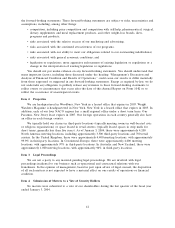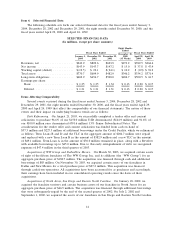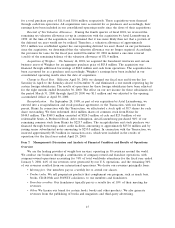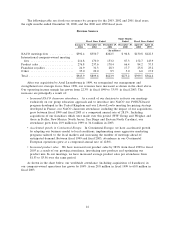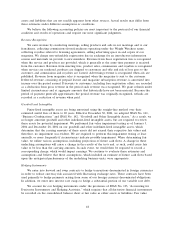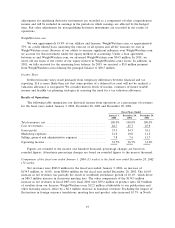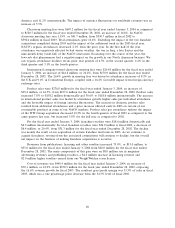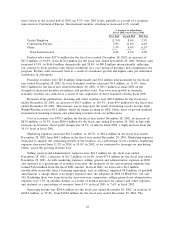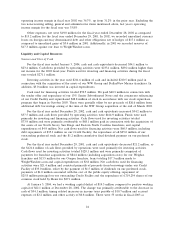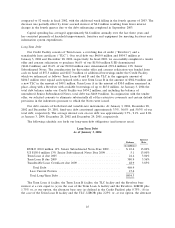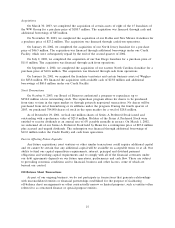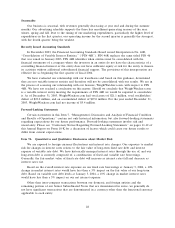WeightWatchers 2003 Annual Report Download - page 24
Download and view the complete annual report
Please find page 24 of the 2003 WeightWatchers annual report below. You can navigate through the pages in the report by either clicking on the pages listed below, or by using the keyword search tool below to find specific information within the annual report.assets and liabilities that are not readily apparent from other sources. Actual results may differ from
these estimates under different assumptions or conditions.
We believe the following accounting policies are most important to the portrayal of our financial
condition and results of operations and require our most significant judgments.
Revenue Recognition
We earn revenue by conducting meetings, selling products and aids in our meetings and to our
franchisees, collecting commissions from franchisees operating under the Weight Watchers name,
collecting royalties related to licensing agreements, selling advertising space in and copies of our
magazine. We charge non-refundable registration fees in exchange for an introductory information
session and materials we provide to new members. Revenue from these registration fees is recognized
when the service and products are provided, which is generally at the same time payment is received
from the customer. Revenue from meeting fees, product sales, commissions and royalties is recognized
when services are rendered, products are shipped to customers and title and risk of loss pass to the
customer, and commissions and royalties are earned. Advertising revenue is recognized when ads are
published. Revenue from magazine sales is recognized when the magazine is sent to the customer.
Deferred revenue, consisting of prepaid lecture and magazine subscription revenue, is amortized into
income over the period earned. Discounts to customers, including free registration offers, are recorded
as a deduction from gross revenue in the period such revenue was recognized. We grant refunds under
limited circumstances and at aggregate amounts that historically have not been material. Because the
period of payment generally approximates the period revenue was originally recognized, refunds are
recorded as a reduction of revenue when paid.
Goodwill and Intangibles
Finite-lived intangible assets are being amortized using the straight-line method over their
estimated useful lives of three to 20 years. Effective December 30, 2001, we adopted SFAS No. 141,
‘‘Business Combinations’’ and SFAS No. 142, ‘‘Goodwill and Other Intangible Assets.’’ As a result, we
no longer amortize goodwill and other indefinite-lived intangible assets, but are required to review
these assets for potential impairment. We performed fair value impairment testing as of January 3,
2004 and December 28, 2002 on our goodwill and other indefinite-lived intangible assets, which
determine that the carrying amounts of these assets did not exceed their respective fair values and
therefore, no impairment was evident. We are required to perform this impairment testing at least
annually, or more frequently if circumstances indicate possible impairment. When determining fair
value, we utilize various assumptions, including projections of future cash flows. A change in these
underlying assumptions will cause a change in the results of the tests and, as such, could cause fair
value to be less than the carrying amounts. In such event, we would then be required to record a
corresponding charge, which would impact earnings. We continue to evaluate these estimates and
assumptions and believe that these assumptions, which included an estimate of future cash flows based
upon the anticipated performance of the underlying business units, were appropriate.
Hedging Instruments
We enter into forward and swap contracts to hedge transactions denominated in foreign currencies
in order to reduce currency risk associated with fluctuating exchange rates. These contracts have been
used primarily to hedge payments arising from some of our foreign currency denominated obligations.
In addition, we enter into interest rate swaps to hedge a substantial portion of our variable rate debt.
We account for our hedging instruments under the provisions of SFAS No. 133, ‘‘Accounting for
Derivative Instruments and Hedging Activities,’’ which requires that all derivative financial instruments
be recorded on the consolidated balance sheet at fair value as either assets or liabilities. Fair value
18






